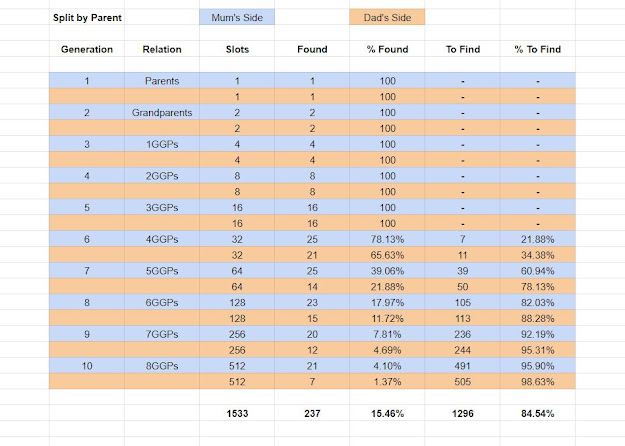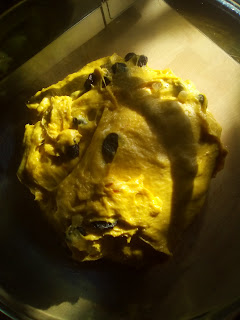In 2016, there was a brief social media craze in the genealogy community around the question: "What's Your Number".
It was a lot of fun as I recall, and the origin point for finding some of my favourite online genealogy friends (though some have later proved to also be extended family).
Naturally, as I'm a human researcher, and given to bouts of being human, my notes from the first round of taking part in this exist only in the hard drive of a dead computer that's living in our spare room, as dead computers are wont to between death, and that point where you skin your shins tripping over it enough to admit defeat and let go of whatever was on there 'now that all these years have passed' with as much grace as you can muster, so unfortunately, I don't have my original notes anymore to make for a handy comparison piece.
However, I did, very recently, identify my last remaining mysterious 3rd Great-Grandmother (GGM) Elizabeth Collicott, to fill out a whole generation, and that tripped the memory for me.
Meanwhile, for those among us who just love a good comparison series to read, I can highly recommend Julie Tarr's blog series, which starts here. She had a go in a first post published 17 Aug 2012, then revisited again in 2015 and 2017 ...and you'll get no spoilers from me.
In looking back, I was reminded of Christa Cowan's episode of 'The Barefoot Genealogist' from 15 Mar of 2016, which built on her Ancestry blogpost of the same name, from 16 Aug 2012.
At time of writing, this video has received 30,420 views (including my re-watching of it in preparation for this), 470 likes (no dislikes), & 66 comments.
This episode delves into all the how and why of this particular method of analysis of your research way better than I ever could, so though I'll touch on a few bits here, that's mostly where I learnt from (with a few additions), so I would still highly recommend giving it a watch when you have time.
In celebration of having filled out that 5th generation (I don't personally count my generation for purposes of this one), especially as last time I did this, there was a whole 1st Great-Grandparents (GGPs) branch who were essentially 'lost' to us, so the landscape is very different now (to say nothing of the advances in DNA for genealogy since), I thought I might revisit this analysis game and bring you along for the fun. Who knows, maybe between us, we might be able to chip a little at each others' brick walls slightly?
Disclaimer: Since I don't start with 'me' as a base for this type of analysis, my numbers will vary slightly from what you might see elsewhere. I'm still a big advocate for do whatever works for you in your research.
First of all, let's start with what we know:
In analysing my master tree I want to also incorporate genetic genealogy (more on my recent experiments with Leeds Method et al in the next while). To do that, I need to get typically to 9th cousins at the outside (so 8th GGPs) which gives me a nice, tidy, 10 generations to play with. Your mileage may vary.
For those 10 generations, theoretically, I should have 2046 'slots' for an ancestor (to borrow verbage from various gaming systems), as follows:
Next, for the slightly daunting bit: How many have I collected so far?
One thing I do know, courtesy of GedMatch, is that so far as currently able to be read, my parents are genetically unrelated, so we're not expecting to find anything in the way of endogamy, so that's the full 2046 individuals I'm chasing. ...sounds about right for this family to be honest. Never do things by halves!
Another thing I know is going to come up, some of the women of these higher up generations, I only have a first name to go on so far, so I'm going to be strict with myself and only include relatives I know a first and last name for.
Well, here goes nothing...
Top Tip: Ancestry shows 5 gens comfortably, so the way I did my counting was, I made a list of all 32 of my 2GGPs (working on the basis of 'an ounce of preparation...'), and made each of them the person whose ancestors were showing, and then for the few who had someone in that last generation, I just used one unfold of the wee arrows by turns.
Okay, so overall, pleasantly surprised. At least something into double figures at every level.
I was expecting the odd one, as I have one line leading from each parent that goes ALL the way back into oral history*. I had no idea that I had quite so much of those upper generations filled out though. Especially the 4GGPs. To have nearly 3/4 of those slots full is fantastic!
However, there's that sense of waiting for the other shoe to drop, so let's look into it further.
To make it easier to manage, I went back and split the table into my maternal and paternal sides, and colour coded it:
The first thing that's quite interesting, is how close it is. It's really close at first: 25 found Mum's side, for 21 Dad's side for 4GGPs, and thereafter it falls away with Dad's side trailing.
Part of that is that for a range of reasons, in the last couple of generations, there hasn't been an abundance of contact, to the point where, until recently, there were a couple of lines that were looking like they might have been 'lost'.
On the plus side though, some of Dad's lines have been extensively researched by a team of family genealogists, headed by the epic cousin Russell in Indiana. Other lines though, there's some interesting situations, and in some cases, records are somewhat thin on the ground. Still, we persist.
The most recently found 3GGM, Elizabeth Collicott, is on Dad's side too, and part of me is leaning towards that 'shiny object syndrome' of having a nice, new (to me) relative to get to know.
Mum's side, it's interesting. Mum's family have always been extremely close, and it's only in the last generation or so that the family has really started to spread out to any great degree. The stories are still told and there are more photos, which definitely helps to keep them 'alive' somehow. That side are also keen users of a variety of communications methods to keep up with each other that bit more regularly.
So, there's this odd equilibrium: Dad's side are heavier (with a couple of exceptions) on genealogical record, but light on the DNA side of things (other than me, only one relative that side within the immediate family has chosen to test so far).
On Mum's side, there are more situations where the genealogical records are more spotty, but we do have the benefit of not only more relatives who have chosen to test, but also, the identical twin factor is very close in to the people who are testing, which can be both a blessing and a curse. The good thing however is, of all the female born offspring of the twins, we have tests for a daughter of each twin and a grand-daughter of each twin, so we cover three out of 4 of the twins' downlines currently.
Interestingly enough, most of our cousin matches are 3rd cousins (4GGPs) or further though, so it's probably worth trying to plug those 7 missing 4GGPs, so as to be able to narrow it down, though in the meantime, given the twin factor, I'm hoping some recent experiments in adapting the Leeds Method may pay off soon (more on that at some stage in the coming months).
* I include it. I'm a huge history nerd and my main job deals in telling stories. I like it. I'm annotating it as far as I can at every turn. I am comfortable, pre-mass literacy, to include oral only sources as tertiary sources. If that doesn't work for you, that doesn't work for you. We're all going to come at this slightly differently, even within the lingua franca.










